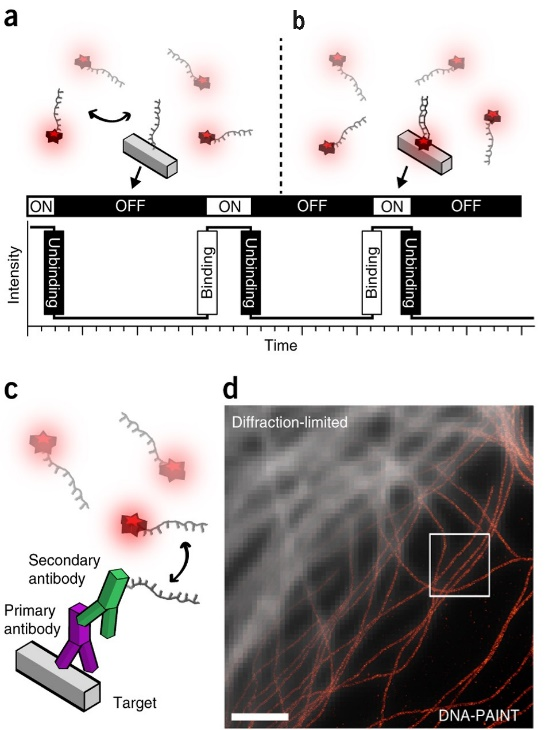Czech Science Foundation Postdoc Individual Fellowship Granted to Ondřej Skořepa
The Czech Science Foundation (GA CR) has awarded funding to a POSTDOC INDIVIDUAL FELLOWSHIP OUTGOING project of Ondřej Skořepa titled “A New Vision: Innovative Imaging Approaches for Investigating the Spatial Organization of Immune Receptors and Ligands“. This project will enable Ondřej to visit the laboratories of Prof. Dr. Ralf Jungmann and Prof. Dr. Petra Schwille at the Max Planck Institute of Biochemistry (Martinsried, Germany) for two years to investigate the molecular organization of NK cell receptor-ligand complexes on the cell surface, especially signaling cluster formation upon mutual interaction of receptors with their respective ligands, using mainly DNA-PAINT super-resolution microscopy and mass-sensitive particle tracking (MSPT) technique of mass photometry.

DNA-PAINT. (a,b) Transient binding of dye-labeled DNA strands (imagers) to their complementary target sequence (docking site) attached to a molecule of interest. The transient binding of imager strands is detected as ‘blinking’, illustrated by the intensity versus time trace. (c) In situ protein-labeling strategy for DNA-PAINT using primary and DNA-conjugated secondary antibodies. (d) Overlay of a diffraction-limited α-tubulin image (top left) with a super-resolved DNA-PAINT image (bottom right).

This project aims to gain insight into NK cell receptor complex formation structural properties in the native state and during cell recognition, to develop and refine methods for monitoring receptor interactions by DNA-PAINT and MSPT, and to strengthen Czech science by implementing these techniques at home laboratory.
With the detailed knowledge we gain about the arrangement of NK cell receptors and their ligands during immune recognition, we are in a much better position to intervene rationally in situations where our own immunity fails (immune evasion and autoimmune responses). Understanding the mechanisms of NK cell activation or inhibition is essential for the rapidly evolving field of immunotherapy, either toward eliminating tumors or enhancing autotolerance. The support of the Czech Science Foundation will help transfer the methodology and knowledge to the national environment, thus strengthening the excellence of Czech science and its relevance in the international field.